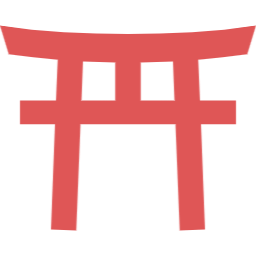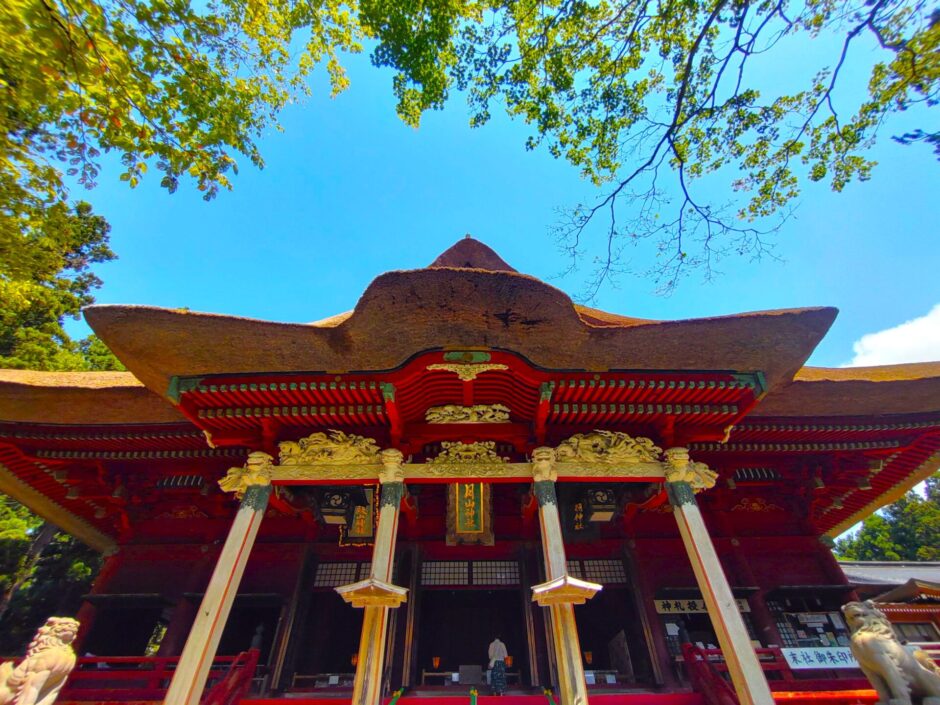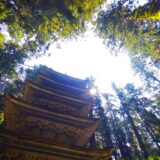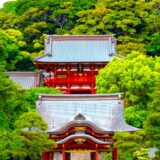Dewa Sanzan Shrine is believed to have been founded around 593. Over 1,400 years ago, Prince Hachiko, the founder of Dewa Sanzan and son of the 32nd Emperor Sujun, unified the Dewa Sanzan mountains and established a shrine on the summit of Mount Haguro. It is said that ascending Mount Haguro, guided by the three-legged crow (Yatagarasu), led to the worship of the true form of the Holy Kannon Bodhisattva (Prince Nōjō) after rigorous training, thereby relieving people’s suffering.
The enshrined deities are Idena no Kami and Ukanomitama no Mikoto.
目次
- 【The Path to Dewa Sanzan Shrine】
- 【Dewasanzan Shrine Bell Tower and Great Bell】
- 【Dewasanzan Shrine San-jin Gōsai-den at Dewa Sanzan (Three Mountains of Dewa)】
- 【Dewasanzan Shrine Mirror Pond】
- 【Dewasanzan Shrine Hachiko Shrine】
- 【Dewasanzan Shrine Tōshō Shrine】
- 【Dewasanzan Shrine Sub-shrine】
- 【Dewasanzan Shrine Ten’yu Shrine and the Statue of Matsuo Basho】
- 【Dewasanzan Shrine GOSHUIN】
- 【Dewasanzan Shrine Nearby attractions】
- 【Dewasanzan Shrine Access】
- Manager’s Comments
- Dewasanzan Shrine
【The Path to Dewa Sanzan Shrine】
There are two routes: one that ascends the stone steps consisting of 2,446 steps, passing through the Suijin Gate and the Five-storied Pagoda, and another that takes the paid Hakubuzan Road (¥400) by car. Both routes lead to the summit where the main shrine stands.
![Mount Haguro Dewasanzan Shrine (Summit)【Yamagata] DSC 2427 1024x768 - Mount Haguro Dewasanzan Shrine (Summit)【Yamagata]](https://japan-shrine.info/wp-content/uploads/DSC_2427-1024x768.jpg)
After climbing the toll road, you’ll find a parking lot. After walking for a while, a torii gate comes into view.
【Dewasanzan Shrine Bell Tower and Great Bell】
Passing through the torii gate, a massive bell tower and great bell come into view. The bell tower is considered the second oldest structure within Mount Haguro, following the five-story pagoda. The great bell was cast in 1275 (the first year of the Kenji era) and has a diameter of 1.68 meters. It is said to be the second largest bell from before the medieval period, after the one at Tōdai-ji Temple in Nara.
![Mount Haguro Dewasanzan Shrine (Summit)【Yamagata] DSC 2429 1 1024x768 - Mount Haguro Dewasanzan Shrine (Summit)【Yamagata]](https://japan-shrine.info/wp-content/uploads/DSC_2429-1-1024x768.jpg)
Both the bell and the bell tower are currently designated as Important Cultural Properties of Japan.
【Dewasanzan Shrine San-jin Gōsai-den at Dewa Sanzan (Three Mountains of Dewa)】
The main shrine is a magnificent structure enshrining the deities of the Dewa Sanzan, towering atop Mount Haguro. It stands as the very heart of mountain worship. A precious thatched-roof wooden structure retaining its medieval architecture, it features the unique combined-shrine design of the ancient Shugendo sect of the Haguro school. Standing 28 meters tall and primarily constructed of cedar, its interior is entirely lacquered in vermilion, while its roof boasts a magnificent thatch 2.1 meters thick.
![Mount Haguro Dewasanzan Shrine (Summit)【Yamagata] DSC 2434 1 1024x768 - Mount Haguro Dewasanzan Shrine (Summit)【Yamagata]](https://japan-shrine.info/wp-content/uploads/DSC_2434-1-1024x768.jpg)
The sheer power of that thatched roof. Photos just don’t do it justice…
![Mount Haguro Dewasanzan Shrine (Summit)【Yamagata] DSC 2436 1024x768 - Mount Haguro Dewasanzan Shrine (Summit)【Yamagata]](https://japan-shrine.info/wp-content/uploads/DSC_2436-1024x768.jpg)
The shrine has suffered multiple fires, and the current main hall was rebuilt in 1818 (the first year of the Bunsei era). It is now designated as an Important Cultural Property of Japan.
![Mount Haguro Dewasanzan Shrine (Summit)【Yamagata] DSC 2442 2 1024x768 - Mount Haguro Dewasanzan Shrine (Summit)【Yamagata]](https://japan-shrine.info/wp-content/uploads/DSC_2442-2-1024x768.jpg)
This shrine features a “triple deity enshrinement” structure allowing worship of all three Dewa Sanzan mountains. The deities of Mt. Gassan, Mt. Haguro, and Mt. Yudono are enshrined within this single hall. It is said that worshiping here grants the same blessings as visiting all three mountains. Its scale is said to be the largest in Tohoku, and it is truly overwhelming. The intricate carvings adorning the shrine are also exquisite.
【Dewasanzan Shrine Mirror Pond】
The sacred waters of Mirror Pond, which spread out before the shrine hall, have been a place for dedicating bronze mirrors since the Heian period and are revered as the divine object. Its water level remains almost constant throughout the year, and as a mysterious sacred pond, it has long attracted deep devotion and served as the center of the Haguro faith.
![Mount Haguro Dewasanzan Shrine (Summit)【Yamagata] DSC 2436 3 1024x768 - Mount Haguro Dewasanzan Shrine (Summit)【Yamagata]](https://japan-shrine.info/wp-content/uploads/DSC_2436-3-1024x768.jpg)
An old text reads “Haguro Shrine” but instructs it to be read as “Ikenomitama,” signifying that this pond was revered as the divine spirit itself. It is a mysterious sacred pond to which deep devotion was offered, and since ancient times, numerous bronze mirrors have been buried here as offerings, hence it is called Mirror Pond.
【Dewasanzan Shrine Hachiko Shrine】
![Mount Haguro Dewasanzan Shrine (Summit)【Yamagata] DSC 2444 1024x768 - Mount Haguro Dewasanzan Shrine (Summit)【Yamagata]](https://japan-shrine.info/wp-content/uploads/DSC_2444-1024x768.jpg)
The founding of Hachiko Shrine, a subsidiary shrine within the precincts, is said to date back to 1619 (Genna 5), when Yushun, then head priest of Mount Haguro, built the Founding Monk’s Hall and enshrined a sacred image of Prince Hachiko, the founder of Mount Haguro Shugendō. It bears the imperial chrysanthemum crest.
【Dewasanzan Shrine Tōshō Shrine】
The founding of Tōshō-sha at Dewa Shrine dates back to 1641 (Kan’ei 18). It is said to have been established by inviting a branch spirit from Nikko Tōshō-gū (Nikko City, Tochigi Prefecture). The current main hall of Haguro-san Tōshō-gū was constructed in 1690 (Genroku 3) in the gongen-zukuri style and was dismantled and restored in 1980 (Shōwa 55).
![Mount Haguro Dewasanzan Shrine (Summit)【Yamagata] DSC 2450 2 1024x768 - Mount Haguro Dewasanzan Shrine (Summit)【Yamagata]](https://japan-shrine.info/wp-content/uploads/DSC_2450-2-1024x768.jpg)
The structure was modeled after the style of its head shrine, Nikko Toshogu, and during the Meiji period, Toshogu was renamed Toshosa. Unlike other Toshogu shrines, its design was somewhat more restrained.
【Dewasanzan Shrine Sub-shrine】
![Mount Haguro Dewasanzan Shrine (Summit)【Yamagata] DSC 2452 1024x768 - Mount Haguro Dewasanzan Shrine (Summit)【Yamagata]](https://japan-shrine.info/wp-content/uploads/DSC_2452-1024x768.jpg)
The subsidiary shrines include: Dairaijinja Shrine, Taketsunumi Shrine, Inarijinja Shrine, Ooyamatsumijinja Shrine, Hakusan Shrine, Omoikane Shrine, and Yasakajinja Shrine.
【Dewasanzan Shrine Ten’yu Shrine and the Statue of Matsuo Basho】
![Mount Haguro Dewasanzan Shrine (Summit)【Yamagata] DSC 2457 1 1024x768 - Mount Haguro Dewasanzan Shrine (Summit)【Yamagata]](https://japan-shrine.info/wp-content/uploads/DSC_2457-1-1024x768.jpg)
I was struck by the incredibly gentle atmosphere of this place, so I looked it up after returning home. This Ten’yū Shrine enshrines Ten’yū Hōin, the 50th Chief Priest of Mount Haguro.
![Mount Haguro Dewasanzan Shrine (Summit)【Yamagata] DSC 2459 1 1024x768 - Mount Haguro Dewasanzan Shrine (Summit)【Yamagata]](https://japan-shrine.info/wp-content/uploads/DSC_2459-1-1024x768.jpg)
Ten’yu was a figure who devoted himself to rebuilding the declining Mount Haguro. However, dissatisfied ascetic practitioners complained about the reforms during the rebuilding, and he was exiled to Niijima in Izu. It is said that Ten’yu spent his days on Niijima without ever returning to Mount Haguro. When Matsuo Basho stopped by Mount Haguro, he concluded his haiku with the line that Ten’yu’s spirit had returned.
【Dewasanzan Shrine GOSHUIN】
![Mount Haguro Dewasanzan Shrine (Summit)【Yamagata] dewasanzan G 1024x641 - Mount Haguro Dewasanzan Shrine (Summit)【Yamagata]](https://japan-shrine.info/wp-content/uploads/dewasanzan-G-1024x641.jpg)
【Dewasanzan Shrine Nearby attractions】
Chidō Museum, Shōnai Shrine, Shōnai Domain School Chidōkan
【Dewasanzan Shrine Access】
Manager’s Comments
The approach to the summit offers many sights, but this time I opted for a more manageable route, stopping at the five-story pagoda before taking the toll road up to the peak. Dewa Sanzan Shrine at the summit feels like a truly special place where history, culture, and natural scenic beauty converge. The main hall, with its thatched roof, was particularly magnificent and truly awe-inspiring. Thinking about how they transported materials by hand back then to build such an enormous shrine hall filled me with deep emotion. Next time, I want to properly visit Mount Gassan as well.
33 Teshimukuhaguroyama, Haguro-cho, Tsuruoka City, Yamagata Prefecture 997-0211
※Free parking available
 Tour of Japanese shrines and temples
Tour of Japanese shrines and temples 

![Mount Haguro Dewasanzan Shrine (Summit)【Yamagata] DSC 2405 520x300 - Mount Haguro Dewasanzan Shrine (Summit)【Yamagata]](https://japan-shrine.info/wp-content/uploads/DSC_2405-520x300.jpg)
![Mount Haguro Dewasanzan Shrine (Summit)【Yamagata] DSC 0220 520x300 - Mount Haguro Dewasanzan Shrine (Summit)【Yamagata]](https://japan-shrine.info/wp-content/uploads/DSC_0220-520x300.jpg)
![Mount Haguro Dewasanzan Shrine (Summit)【Yamagata] DSC 0192 520x300 - Mount Haguro Dewasanzan Shrine (Summit)【Yamagata]](https://japan-shrine.info/wp-content/uploads/DSC_0192-520x300.jpg)
![Mount Haguro Dewasanzan Shrine (Summit)【Yamagata] DSC 2431 520x300 - Mount Haguro Dewasanzan Shrine (Summit)【Yamagata]](https://japan-shrine.info/wp-content/uploads/DSC_2431-520x300.jpg)
![Mount Haguro Dewasanzan Shrine (Summit)【Yamagata] DSC 0581 520x300 - Mount Haguro Dewasanzan Shrine (Summit)【Yamagata]](https://japan-shrine.info/wp-content/uploads/DSC_0581-520x300.jpg)
![Mount Haguro Dewasanzan Shrine (Summit)【Yamagata] DSC 0610 1 520x300 - Mount Haguro Dewasanzan Shrine (Summit)【Yamagata]](https://japan-shrine.info/wp-content/uploads/DSC_0610-1-520x300.jpg)
![Mount Haguro Dewasanzan Shrine (Summit)【Yamagata] DSC 2213 520x300 - Mount Haguro Dewasanzan Shrine (Summit)【Yamagata]](https://japan-shrine.info/wp-content/uploads/DSC_2213-520x300.jpg)
![Mount Haguro Dewasanzan Shrine (Summit)【Yamagata] DSC 2242 520x300 - Mount Haguro Dewasanzan Shrine (Summit)【Yamagata]](https://japan-shrine.info/wp-content/uploads/DSC_2242-520x300.jpg)
![Mount Haguro Dewasanzan Shrine (Summit)【Yamagata] DSC 2524 520x300 - Mount Haguro Dewasanzan Shrine (Summit)【Yamagata]](https://japan-shrine.info/wp-content/uploads/DSC_2524-520x300.jpg)
![Mount Haguro Dewasanzan Shrine (Summit)【Yamagata] DSC 2405 150x150 - Mount Haguro Dewasanzan Shrine (Summit)【Yamagata]](https://japan-shrine.info/wp-content/uploads/DSC_2405-150x150.jpg)
![Mount Haguro Dewasanzan Shrine (Summit)【Yamagata] 2754815 m 150x150 - Mount Haguro Dewasanzan Shrine (Summit)【Yamagata]](https://japan-shrine.info/wp-content/uploads/2754815_m-150x150.jpg)
![Mount Haguro Dewasanzan Shrine (Summit)【Yamagata] DSC 2168 2 150x150 - Mount Haguro Dewasanzan Shrine (Summit)【Yamagata]](https://japan-shrine.info/wp-content/uploads/DSC_2168_2-150x150.jpg)
![Mount Haguro Dewasanzan Shrine (Summit)【Yamagata] DSC 2286 150x150 - Mount Haguro Dewasanzan Shrine (Summit)【Yamagata]](https://japan-shrine.info/wp-content/uploads/DSC_2286-150x150.jpg)

